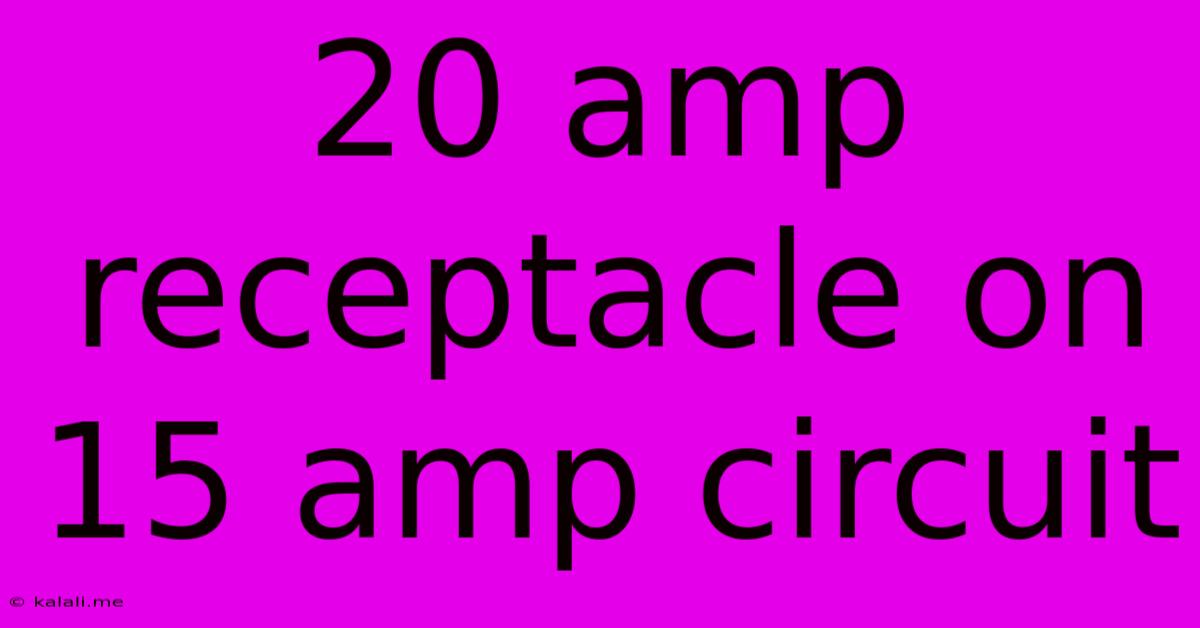20 Amp Receptacle On 15 Amp Circuit
Kalali
Jun 06, 2025 · 3 min read

Table of Contents
Is a 20-Amp Receptacle on a 15-Amp Circuit Safe? A Comprehensive Guide
Plugging a 20-amp appliance into a 15-amp circuit is a common concern among homeowners and electricians alike. While a 20-amp receptacle might seem like an upgrade, using it on a 15-amp circuit raises important safety questions. This guide dives deep into the implications of this setup, exploring the risks, code compliance, and best practices.
Understanding the Basics: Amps, Circuits, and Receptacles
Before we delve into the specifics, let's clarify some fundamental electrical terms. Amps (amperes) measure the rate of electrical current flow. A circuit is a pathway for electricity, typically protected by a circuit breaker or fuse. The breaker's rating (e.g., 15 amps) determines the maximum current it allows before tripping. A receptacle is the outlet where you plug in appliances. A 20-amp receptacle is physically larger than a 15-amp receptacle, accommodating larger appliance plugs.
The Problem: Mismatched Capacity
The key issue lies in the mismatch between the receptacle's capacity (20 amps) and the circuit's capacity (15 amps). While you can use a 20-amp receptacle on a 15-amp circuit, it's crucial to understand the implications: the circuit breaker will still only allow a maximum of 15 amps to flow. Plugging in a high-draw appliance might overload the circuit, potentially leading to overheating, fire hazards, and damage to your appliances. This is a significant safety concern.
Code Compliance: NEC Requirements
The National Electrical Code (NEC) provides guidelines for safe electrical installations. While it doesn't explicitly prohibit a 20-amp receptacle on a 15-amp circuit, it strongly recommends using receptacles that match the circuit's amperage. This practice ensures that the wiring and protection devices are properly sized for the load. Deviating from this can lead to violations and invalidate insurance claims in case of an electrical fire.
Common Scenarios and Their Risks:
- High-draw appliances on a 15-amp circuit: Using high-wattage appliances like space heaters, hair dryers, or microwave ovens on a 15-amp circuit can easily overload it, especially if multiple devices are running simultaneously. This is where the risk of overheating and fire becomes a serious concern.
- Future upgrades: While it might seem convenient now, using a 20-amp receptacle might create issues if you decide to upgrade your circuit in the future. You'll have to replace the receptacle, adding extra time and expense to the process.
Best Practices: Matching Receptacles to Circuits
To ensure safety and code compliance, always match the receptacle's amperage rating to the circuit's amperage rating. This means using a 15-amp receptacle on a 15-amp circuit and a 20-amp receptacle on a 20-amp circuit. This simple practice significantly reduces the risk of electrical hazards.
When a 20-Amp Receptacle Might Be Acceptable (with Caveats):
There are rare exceptions, usually involving specific installations or renovations. A qualified electrician can assess the situation and determine if a 20-amp receptacle is appropriate, but it almost always involves upgrading the wiring and breaker to meet the higher capacity.
Conclusion: Prioritize Safety
Using a 20-amp receptacle on a 15-amp circuit is generally not recommended. While it might not immediately cause problems, it introduces unnecessary risks. Adhering to NEC guidelines and matching receptacle and circuit amperages is crucial for ensuring a safe and reliable electrical system in your home. If you have any doubts or questions, always consult a qualified electrician. They can provide expert advice and ensure your electrical system is safe and up to code.
Latest Posts
Latest Posts
-
Fill A Hole In Concrete Floor
Jun 06, 2025
-
Why Is My Audi Delayed With A New Cord
Jun 06, 2025
-
Why Apache Display Full Server Path
Jun 06, 2025
-
Do You Need An Id For A Greyhound Bus
Jun 06, 2025
-
What Is The Purpose Of A Neutral Wire
Jun 06, 2025
Related Post
Thank you for visiting our website which covers about 20 Amp Receptacle On 15 Amp Circuit . We hope the information provided has been useful to you. Feel free to contact us if you have any questions or need further assistance. See you next time and don't miss to bookmark.